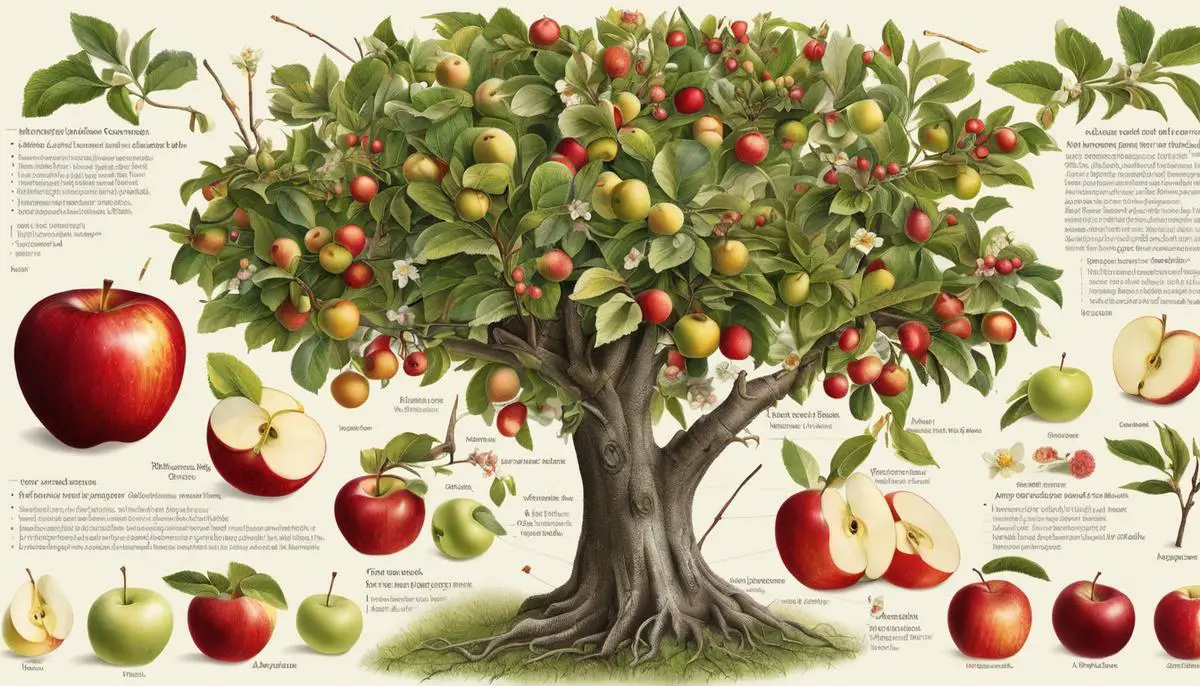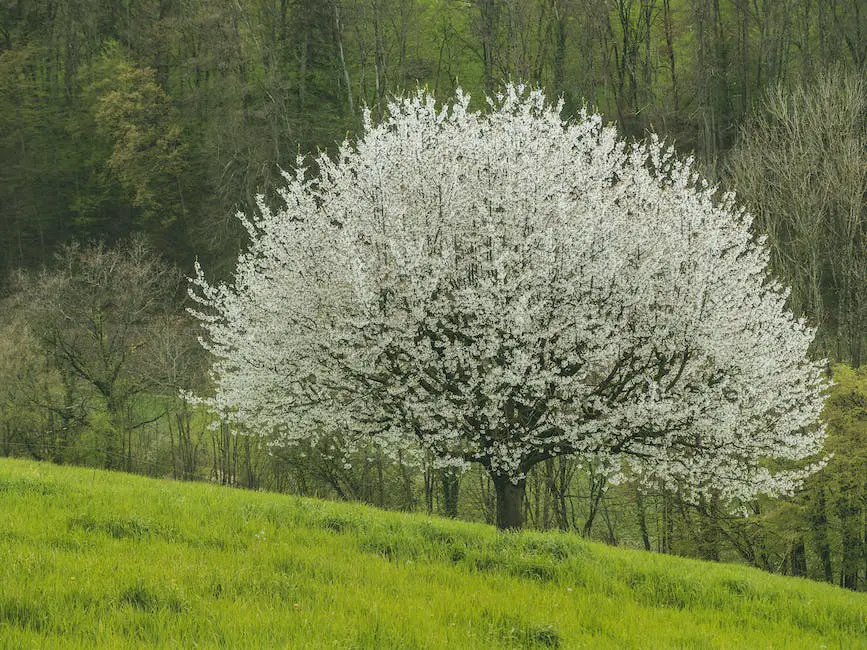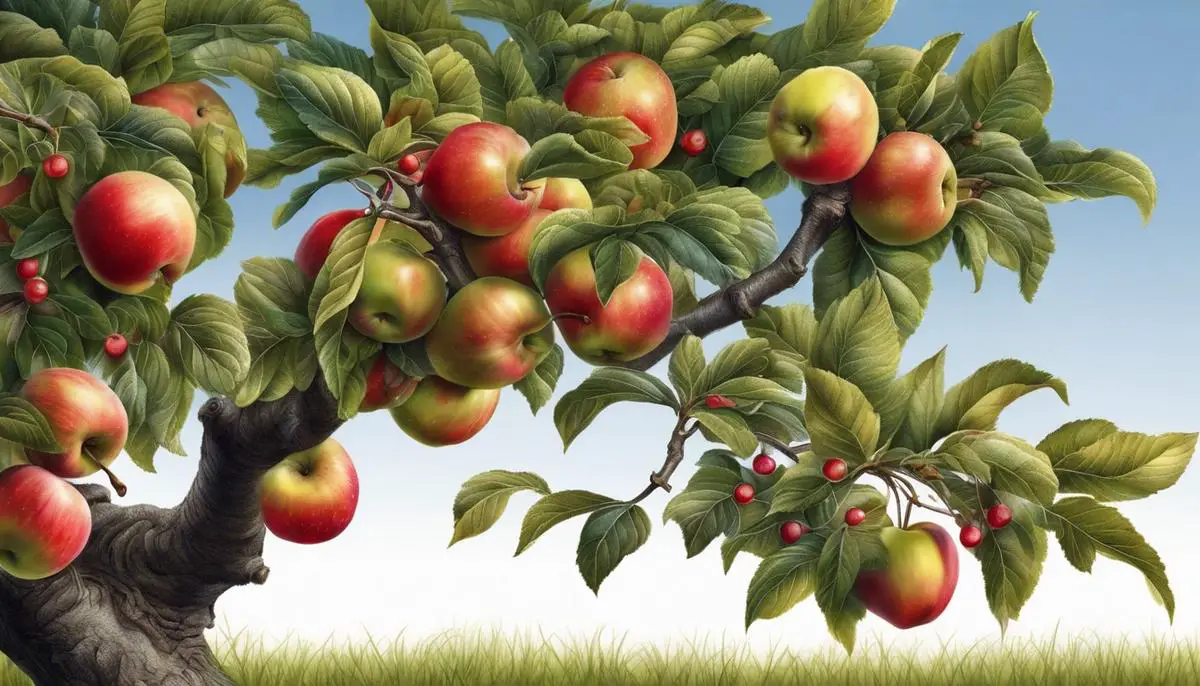The miracle of life, an enigma universally cherished and universally explored, manifests itself remarkably in the realm of the humble apple tree. Delicate blossoms and lush green leaves silently narrate their perpetual journey of survival and propagation. With a thread of life weaving itself inextricably through every leaf, stem, and blossom, the phenomenon of apple tree reproduction encompasses a wide array of biological, ecological, and human-induced factors. The journey starts from the very fundamental anatomy and physiology of apple trees, sheds light on the indispensable role of bees in pollination, and culminates at understanding the human involvement via apple tree propagation and cultivation. The fascinating lifecycle of this fruit-bearing beacon of fertility is a paradigm of the intricate machinery of nature; one where a myriad of factors coalesce, dues are paid, and apple trees reproduce, in a symphony of continuity.
Anatomy and physiology of apple trees
The Indispensable Role of Apple Tree Anatomy in its Reproduction
The apple tree, known scientifically as Malus domestica, is a wonder of botanical physiology and reproduction. Intricate by design, it has evolved to ensure not only its survival but also its proliferation across various climates and geographies. This article explores the role of apple tree anatomy in its reproductive process, providing a glimpse into the intricate, yet marvelously streamlined, symbiosis of structure and function.
Firstly, the apple tree’s anatomy is finely tuned to encourage cross-pollination. This process involves the transfer of pollen between different individual plants, thus promoting genetic diversity.
The apple tree’s blossoms, or flowers, are the primary reproductive structures. Each blossom contains male stamens, laden with pollen, and a female organ called the pistil. The stamens, conveniently situated, allow the transfer of pollen via biotic vectors, mostly bees that are drawn by the flower’s nectar and color. On approaching the flower, the bees inadvertently collect pollen on their bodies, which consequently rubs off on the pistil of the next apple flower visited, thus ensuring cross-pollination.
Each pistil, or female reproductive organ, is configured with a receptive stigma – the part where pollen grains adhere. From here, these grains embark on an expedition down the pollen tube, which leads to the ovules harbored within the ovary. This journey culminates in fertilization, which is the fusion of the male sperm cells (contained in the pollen) with the female egg cells (inside the ovule).
Post-fertilization, the fertilized ovules metamorphose into seeds and the ovary transforms into the apple fruit we all are familiar with. This dual change serves a dual purpose: the fleshy, nutritious fruit invites a variety of seed dispersers, ensuring broad seed distribution, while the hard seed coat protects the precious embryonic plant within from damage during transit.
Moreover, the apple tree’s distinctly branching architecture further complements reproduction, providing an expansive platform for blossoms. More blossoms imply more chances of cross-pollination and, thus, more fruit.
The intricate balance of structural design and function in apple trees along with the significant role they play in fruit production, highlight the ineffable beauty of Nature’s depth of detail. As we bite into the crunchy freshness of an apple, let us spare a moment to appreciate the sophisticated, scientific drama that unfolded to bring about its existence. And savor not just the fruit, but also the wonder that is the apple tree’s anatomy.

Pollination: Bees and apple tree reproduction
The Bee: A Vital Link in the Reproduction of Apple Trees
It’s a ballet of nature; bees buzzing from bloom to bloom, unwittingly driving the essential act of cross fertilization in apple trees, a process that ultimately results in the luscious apples we savor.
The humble honeybee, Apis mellifera, acting as a pollinator, plays a pivotal role in the reproduction of apple trees. They’re consummate workers, pollen collectors, and vital lifelines for hundreds of plant species, including apple trees.
Consider this: a bee lands on a blossom, drawn by the nectar deep within the flower. As it forays into the blossom’s inner sanctum, pollen grains from the male stamens hitch a ride on its fuzzy body. When the bee moves on to another blossom, some of those sticky pollen grains rub off on the female pistils, kick-starting the process of fertilization.
An apple tree’s anatomy is designed with this bee-assisted pollination in mind. Meticulously evolved over the years, their blossoms are intricate structures that beckon bees and other pollinators. The flamboyant petals act like runways guiding bees to the nectar, while the stamens and pistils act as departure and arrival terminals for delicate pollen grains.
A tree’s branching architecture further aids this delicate ballet. Their branches spread out like a web, offering maximum surface area exposure to the elements – sunlight, wind, and, of course, pollinators like bees. It’s a master-class in form meeting function, making the dance of pollination more effective, efficient, and successful.
An apple tree’s reproductive success is indeed intimately tied to the humble bee. Each pound of apples picked from a tree is a testament to the countless micro-interactions between bug and bloom. It’s a dance of the ecosystem, an intricate interconnected ballet where each partner relies on the other for survival.
Without these bees to act as middlemen, apple trees would find fertilization, and hence apple fruit production, drastically reduced. In that sense, we can say that the honeybee, with a role of such profound importance unseen to the naked eye, is truly the unsung hero of an apple’s cultivation and proliferation.
So the next time we bite into a crisp apple, perhaps we should spare a thought for these tiny laborers. With each sweet bite, we are tasting the fruit of their labor; a labor that is essential, not just for the apple tree’s survival, but also for the rich biodiversity of our ecosystems, and indeed for our very sustenance.

Apple propagation and cultivation
Apple propagation and cultivation is a topic that combines an intricate mesh of biology, environmental science, and a deep respect for nature’s delicate systems. When discussing this topic, it is vital to pay particular attention to methods of apple propagation, apple tree care and maintenance, pest and disease management, and harvest techniques.
To propagate an apple tree, the most common technique employed is grafting. Grafting involves the transfer of a scion (a small twig or bud containing the desired genetic traits) from the parent apple tree onto a rootstock. This rootstock could be from a different apple tree optimized for growth characteristics such as disease resistance, soil adaptation, or size control. This fusion of the rootstock and the scion ensures the perpetuation of a specific apple variety and meets the demands of contemporary apple farming, from cultivation to the market demands.
Apple tree care and maintenance are pivotal to successful growth and fruit production. Nourishment through scheduled and balanced fertilization ensures healthy tree growth. It includes the provision of essential nutrients, such as nitrogen, potassium, and phosphorous, directly influencing apple quality and enhancing yield. Moreover, pruning plays a crucial role in maintaining the desired shape and size of the tree, promoting enough sunlight penetration and air circulation to minimize disease occurrence.
Pest and disease management is another critical aspect of apple tree cultivation. For instance, codling moths, aphids, and apple maggot flies pose significant threats to apple production, necessitating proactive pest control measures. Efficacious pest management might involve integrated pest management strategies combining cultural, biological, and chemical control methods. Meanwhile, apple tree diseases, such as apple scab and fire blight, call for preventative measures and timely treatment through fungicides and antibacterial sprays respectively.
Lastly, harvest techniques are essential to gathering mature fruits without causing harm to the tree or the fruit. When apples appear ripe – presenting vibrant color, easy separation from the tree, and a sweet, crisp taste when sampled – careful handpicking is essential to prevent bruising or damage that would hasten deterioration. The harvest involves a gentle twist-and-pull action to detach the apple from the tree, usually leaving the stem intact on the fruit.
In conclusion, the intricacies of apple propagation and cultivation blend science, patience, and the dedicated stewardship of our remarkable fruit-bearing trees. From thoughtful propagation techniques to intense care, pest prevention, and eventual harvesting, each stage of this process mirrors the fascinating life cycle of apples, offering testament to the balance and interconnectedness of our natural world.

Indeed, the reproduction of apple trees is a multifaceted phenomenon steeped in the depth of nature’s complexity and man’s cultivation practices. They are living testament to the fascinating interplay of anatomy and physiology, cross-pollination buoyed by bees, and the contributions of human propagation methods. Evidently, apple tree reproduction isn’t an isolated event but a compelling narrative that involves the tree’s structure, the silent diligence of bees, and human intervention. The exploration of such an intriguing subject underscores the interconnectedness of life itself, and paints a larger picture of the interdependence that shapes nature’s roll of dice in the grand game of reproduction and survival.
